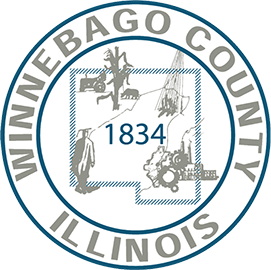The Winnebago County surface water management ordinance applies to unincorporated areas of Winnebago County, Illinois.
The Winnebago County Surface Water Management Ordinance deals with Stormwater Detention, Floodplain Regulation, and Construction Site Sediment and Erosion Control. It consists of two parts: the main Ordinance summarizing the requirements, and a Technical Regulation, providing details for compliance. Both were adopted by the Winnebago County Board on August 24, 2006, though they were based on earlier versions of similar rules.
History
Thirty years ago, the County recognized that clearing our forests and farmlands and replacing them with the rooftops, parking lots, and other paved surfaces of residential and commercial development increased stormwater runoff--and thus flooding potential. To slow this runoff rate down and store it for more gradual release, Winnebago County began requiring stormwater detention in 1976.
In 1980, the first floodplain mapping for the county became available from the Federal Emergency Management Agency (FEMA). These maps were a more comprehensive basis for protecting developments from flood damages than the designation of "excess stormwater passageways" that the existing Stormwater Detention Ordinance required. They also prevented encroachments into floodways that would back up or redirect floodwaters onto other properties.
Formal Floodplain Regulations were therefore merged with the detention requirements and the Natural Hazard Ordinance was created. Besides the flood protection benefits, the adoption and enforcement of these regulations allowed the Flood Insurance Administration to make flood insurance available to residents and businesses in the County; which also enabled certain mortgage types (FHA, VA) in floodplains.
The Clean Water Act of 1972, and subsequent years, brought recognition to the alarming rate of quality degradation in our nation's waters. Much improvement has been made since that time, especially regarding point sources of pollution: things like industrial or sewage plants that dumped raw waste into surface waters. Non-point sources of a diffuse nature have now gained more attention.
One of these non-point pollution sources is the construction site. Here protective vegetation is stripped off and the exposed soil can be eroded away by stormwater flow (and wind) and be deposited as silt and pollutant clouds in lakes, rivers and other surface waters to the detriment of aquatic life and many beneficial uses. It's not just a water (and air) quality issue either, as the sedimentation of these surface waters reduces flood storage capacity, and can clog drainage pipes and ditches to reduce their flow carrying capacity.
Winnebago County has included erosion and sediment control provisions for Detention and Floodplain construction areas since the beginning, and for Subdivisions [Chapt.74, sec.74-12(d)(10)] since March, 2003; but the regulations have been rather vague--without actual compliance measures spelled out and inspection⁄violation indicators specified; and did not include all types of development.
In 2003, all development operations disturbing an acre or more have been regulated by the Illinois EPA, but local jurisdictions have been increasingly involved with erosion and sediment control issues, subject to the US Environmental Protection Agency's (EPA) National Pollutant Elimination System (NPDES), Phase II. We have joined forces to create the Winnebago County Association for Clean Water Action---WinACWA, for short.
One of WinACWA's first major efforts was to write a model Construction Site Erosion and Sediment Control Ordinance that could incorporate the same specific measures for any jurisdiction. Administrative details would obviously differ in accordance with each jurisdiction's organizational structure, but one set of specifications made it easier for developers, designers, and the general public to review; and ultimately comply with final ordinances. The public input process extended from July 14 to September 15, 2004, comments were reviewed, and the model finalized by the end of October, 2004.
At the same time, FEMA had begun using the vastly superior data (2001 aerial photography and 2-foot elevation contours) of the Winnebago County Geographic Information System (WinGIS) to update its floodplain maps; making them more accurate and in a modernized, countywide format. These maps have at last been finalized and become available. Now, just as many other communities included in the Countywide maps, the County must adopt them for enforceability.
A third need is Post Construction Runoff Controls. Under the NPDES Phase II program, mentioned previously with Erosion and Sediment Controls, the County must to address measures that. like stormwater detention, reduce the effects of land development in a more permanent way.
Thus, the county has adopted an ordinance that:
- retains the 1976 Stormwater Detention Requirements;
- revises the Floodplain Regulations to meet current FEMA maps and standards;
- adds new requirements for Construction Site Erosion and Sediment Control and Post Construction Runoff Controls.
- and, by the way, changes the name to something more representative of what's being regulated: from 'Natural Hazard Ordinance' to 'Surface Water Management Ordinance' (SWMO).
For questions regarding the Winnebago County Surface Water Management Ordinance, please contact the Highway Department at (815) 319-4000 or

